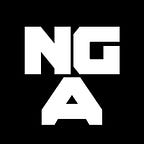OK Computer
NGA Curator Sarina Noordhuis-Fairfax untangles the relationship between man and machine in artist Kieran Browne’s contemporary digital art project.
Computer scientist, researcher and… artist? Never one for colouring between the lines, the multi-talented Kieran Browne fuses art, technology and human motion to create hypnotizingly beautiful digital drawings. Feeding his fascination with the representation of technology, Browne developed Trace, an interactive map of visitor movements now on display in the NGA’s Performing Drawing exhibition.
Given that this live-mapping project involved some complicated technology, what is the simplest way of describing Trace?
In the Performing Drawing gallery, I’ve mounted a simple, single-board computer called a raspberry-pi on the ceiling with a camera and a fish-eye lens. The camera takes 15 images per second of the room below. The computer program then compares whether anything has changed between each frame, and discards everything that remains the same.
Trace asks how different each pixel is to the empty room — if it is significantly different, then the program draws it in. The resulting daily map works like a long-exposure photograph, where each person’s movement generates a pale grey inky line on the display screen. This aggregate of pixels becomes an archival experience of the exhibition.
Sometimes soft and smooth, sometimes fiercely energetic, the lines reveal paths taken by visitors as they walk through the exhibition. The artwork interacts with people as people interact with the artwork, generating a sympathetic and dynamic relationship between human and machine.
Can you describe how the imagery of Trace came about?
It was one of those happy accidents of process. I wanted some sort of structure so that the rendered image works visually. I didn’t want to recreate the aesthetics of a photo — I wanted to develop something more like calligraphy, which looks like the adding of water in an ink wash drawing.
There is an intentional quality to the lines in Trace. The photographic system creates a form of ‘noise’, compared with the clean lines that might be generated through a purely digital drawing. When we see noise in an image, such as the rough edges of a charcoal line, it looks more natural.
Visitors to the gallery are not individually identifiable in this project. Can you talk about the importance of anonymity?
There are lots of artists who engage with questions about surveillance. Their projects probe at boundaries, subverting the system to create a feeling of discomfort, of being watched.
In Trace, individuals are not identifiable beyond the path they walk through the space, which shows up as a dark line.
I am much more interested in commenting on visibility, without contributing to the near constant surveillance of modern society.
Trace gives people the opportunity to seamlessly become part of an artwork — they’re at once subjects and participants, anonymous and obsessively, meticulously recorded.
Experience Trace and become one with the mainframe in the NGA’s Performing Drawing exhibition, open now.
